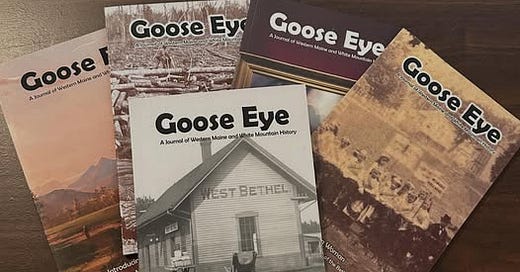Goose Eye No. 5 (2025)
Editorial
With this fifth issue of Goose Eye, we take a slightly different approach. For the first time, our focus is not a broad topic, but a single place: the village of West Bethel. From time to time in future issues, we hope to do the same with other communities in the region. The aim of these issues will not be to offer a comprehensive local history, but to highlight a few particularly intriguing or illuminating stories—the riddles or curiosities that linger in the place’s past.
West Bethel lends itself particularly well to this sort of treatment. Its village center was once dubbed “Gander Corner” after a local legend that two men once stole a gander from a nearby farmer and roasted it on a blacksmith’s forge. Though legally a part of the town of Bethel, the village has always had its own unique identity. The village retains its own post office and for many years could boast many of its own shops and businesses and civic institutions.
We open with the story of one of those institutions, the Pleasant Valley Grange, as experienced by one of its longtime members, Pauline Applin. Pauline told her story to sound artist Dianne Ballon as part of a celebration and oral history project that took place over two decades ago, but the interview is published here for the first time.
At the center of this issue is Larry Glatz’s study of Edwin Briggs—or “Ruthven,” the nom-de-plume by which he was known to his readers and solvers. A prolific puzzle-maker whose work appeared in newspapers across the country, Briggs lived for much of his adulthood in West Bethel, and his life—much like his creations—remains a puzzle in its own right.
My own contribution explores the curious rise and sudden relocation of the Whitten & Dennison Post Card Company, a postcard publisher founded in West Bethel in 1907. In just three years, it outgrew its rural origins and moved its operations to Indiana, leaving behind a brief but striking local legacy.
What fun it was to put together a few pieces of the company’s history—including solving the mystery of why I could not, at first, locate one of the company’s founders, Louis G. Whitten, in his Bates College yearbook—but many questions remain.
In our regular “From the Archives” department, we feature the full text and selected illustrations from the “Gander Corner Bugle,” a handwritten newspaper filled with cryptic humor, obscure references, and inside jokes. As with other amateur papers of the nineteenth century, much of its meaning is now difficult to decode—but therein lies its charm.
In our “Collection Spotlight,” we showcase a set of photographic postcards from the collection of Libbie Kneeland, capturing West Bethel as it once was: a mix of buildings that retain their basic appearance today, others that have undergone major transformations, and many now lost. Though they speak silently, these images hint at both the known history of the village and the many untold stories now long forgotten—enigmas in their own way.
Finally, lest our investigation of the particularities of West Bethel village lead us to forget that all events unfold against a broader backdrop, David Jones contributes an essay on the importance of context in local history.
We hope this issue will encourage readers to see West Bethel not just as a dot on the map, but as a place with character, mystery, and a history worth exploring.
William F. Chapman
May 2025




